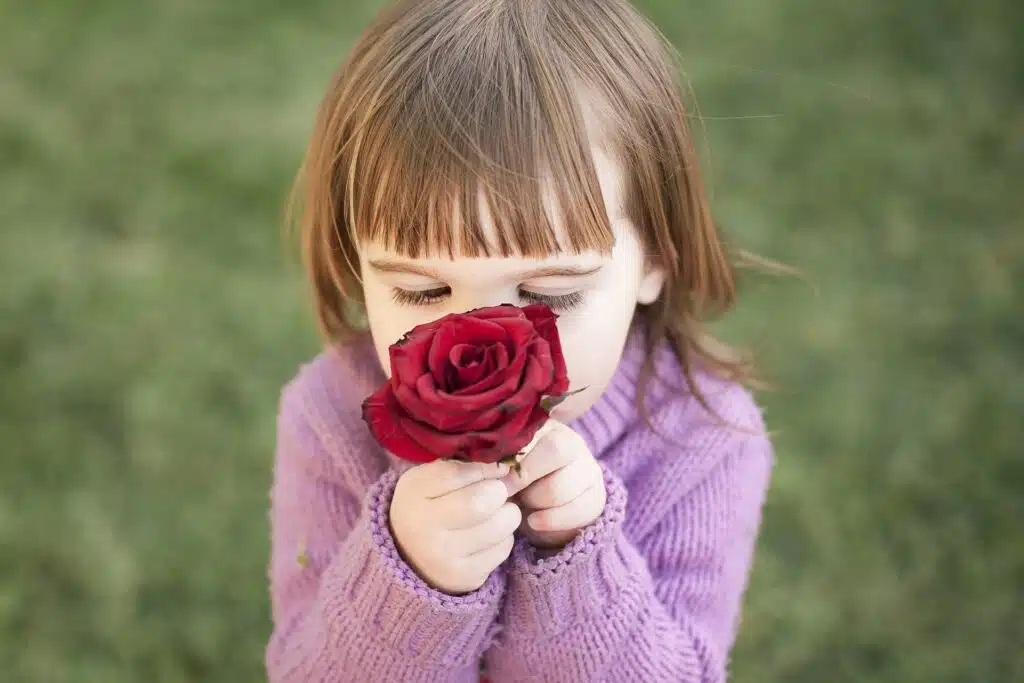
Our sense of smell is so important. Just imagine life without ever smelling your favorite delicious food. People who experienced a loss of smell during the recent pandemic talked about how strange life was without their sense of smell.
How dull food became. Imagine not being able to smell the beautiful scents in nature or the wonderful aroma of fresh bread or pizza baking. What if we did not have the sense of danger that hits us if we smell smoke, gas, or rotten food?
For a baby or toddler, their parent’s smell is also connected with safety and love. Yet, our sense of smell is probably the most overlooked of all our senses.
The Importance Of The Sense Of Smell In Learning
Developing the sense of smell in preschool children is important as it helps them make sense of the world around them, which will help their overall understanding and development. The sense of smell is reportedly the sense that is most closely linked to our emotions.
Certain smells can trigger memories far quicker than a sound or a taste, which can send us back instantly. Think about the smell of your grandmother’s favorite perfume or the smell of school dinners – it can send us reeling back in time.
With that in mind, read on for some ideas to introduce your pre-schoolers to some sensory-smelling activities:
1. Scented Play Dough
This is a must. I find that homemade play dough is always better than the ready-made varieties, as you can make a large enough amount for all the children to have a decent amount to play with. You can add a few drops of essential oil to the play dough to give it a lovely scent which will be released as the children roll and stretch it. My favorite essential oils to try are:
- Lavender
- Peppermint
- Chamomile
- Orange.
- Eucalyptus
You can rotate the different scents when you make a batch of play dough. Talk to the children about the scents and see which ones they prefer. Also, add a few drops of scented body lotion for smooth and perfumed play dough. Always remember to check for allergies first.
A few drops of lavender oil are my favorite way to bring calm into a Nursery, and you can use it successfully too. Just add a few drops to a cushion for a relaxing new feel to a cozy corner.
2. A Sensory Smelling Walk
This is a good way to encourage children to tap into their sense of smell and to realize how many smells there are around us. Go on a smelling walk around your house or Nursery and stop to smell the various scents, both good and bad. Talk about what you can smell and if you like it or not. Some good points to stop at are:
- Inside the washing machine
- The bin
- The grass/flowers
- House plants
- Soap/shower gel/bubble bath
- Coffee/tea
- Fruit bowl
- Dog/cat food
- Inside the fridge
Make it lots of fun. Pull funny faces at the “bad” smells and see if the children can tell you their favorite smells and why.
3. Guess The Smell
In paper cups or recycled containers, place some cotton wool balls. Wet them with various scents. You could try the following:
- Vinegar
- Vanilla essence
- Lemon juice
- Orange juice
- Peppermint essence
- Pepper sauce
In other cups, you could add small pieces of:
- Onion
- Orange peel
- Curry powder
- Banana
Make a small hole in the lid of the cup to smell through.
You can be as creative as you like here and add as many other smells as you want to. Ask the children to guess what they think and talk about it. What does it do to their nose? Do they like it? Have lots of fun and laughter doing this together.
4. Sort The Smell
When you have tried all the smelling pots and talked about all the different smells, you can sort the pots into smells that the children liked and smell they didn’t like. This should provoke many discussions and be prepared – not everyone will agree.
Try to sort the pots into two piles, but you may need to make a pile that is both liked and not liked.
5. Scented Water
A water try is a wonderful resource in developing children’s early sensory development. Warm water works best when adding essential oils. Try adding a few drops of:
- Scented Bubble bath
- Lavender oil
- Tea-tree oil
- Peppermint oil
- Lemon juice
- Bath salts
Then all you need to do is let the children play and talk to them about how it makes them feel. Always remember to check for allergies first.
Follow the link below for other similar activities:
https://fun-a-day.com/scented-sensory-activities-for-kids/
6. Compost Bin
Recycling food waste should be something we are all doing every day at home and in Nursery. Encourage the children to participate by putting their waste into a compost bin after their meals or snacks.
Waste, like apple peel, orange peel, and banana peel, all have a strong smell. Show the children where the compost pile is if you have one, and let them see the changes to the waste as it rots down. Make recycling food waste a regular part of their day. Talk about the smells – how it looks and how the waste changes.
7. A Smelly Story
Retell a favorite story but pause and reflect, as you tell it, on some of its smells. Here are a few examples, but you can adapt any story by following the same principle.
Goldilocks
Think about which smells would be in the woods as Goldilocks walks through them. What would a house smell like that bears live in? Ask what porridge smells like. Would Goldilocks smell the bears when they get home?
Cinderella
Talk about the smell of cinders in the fireplace, the smell of a pumpkin, smells at the royal palace, party food and drinks, and the smell of the ugly sister’s feet as they try on the glass slipper.
Hansel and Gretel
Talk about the smells in a forest at night, the smell of a house made out of sweets and candy, and the smell inside an old witch’s house.
Get an idea? There is no need to go overboard; just stop and pause for thought at key moments to start thinking about and introducing the sense of smell.
8. Smelly Words
It’s important to give young children the vocabulary to describe their sense of smell. Choose some interesting items to start a talk about our sense of smell. If you can, try to use contrasting smells. Choose items like :
- a rose in bloom
- an onion or garlic bulb
- a bottle of perfume or aftershave
- a rotten potato
As you talk about the different smells, introduce words like perfume, scent, aroma, sweet, smelly, sour, rotten, spicy, and flowery. Repeat the activity later with some different objects to reinforce the new words.
9. Smelly Art
Most people have some old spices lurking in their kitchen cupboards that are going out of date. If you are doing this activity in a Nursery or preschool, why not appeal to your parents to donate any old herbs or spices they have? Then you can use them on a sensory art day.
- Draw pictures with glue sticks and shake curry powder and spices onto them. Hold up the paper/card to reveal your picture.
- Add herbs and spices to ready mixed paint for a sensory-smelling painting experience.
- Use a little curry powder/turmeric and water mixed to paint.
(Remember to check for allergies first).
10. Outdoor Swamp
In the corner of your outdoor area, leave some fruit and vegetables and a pile of old grass cuttings to rot down. Let the children make a small world swamp area by arranging the rotting pile. Add a few dinosaurs, people, and boats, and let them play in the stinky swamp.stinky swamp.
For more ideas, follow the:
Recent research has proved a connection between a child’s sense of smell and a child’s behavior. We can use this information to influence our children’s behavior.
Certain scents can calm and soothe a child (like lavender), just as other smells can trigger unwanted behaviors. We are all different, and all have different life experiences, so the smell of aftershave may have good connotations for one child but may make another child feel uncomfortable or threatened, depending on their connotations with that scent.
It’s worth remembering the power that certain scents can have. The more aware we are, the more we can look out for children who may react badly to certain scents, and we can have a more understanding approach.
Make each activity full of fun and giggles, as children learn best when they are having fun. Check out https://earlyimpactlearning.com/happy-minds-academy/ for better ideas.
